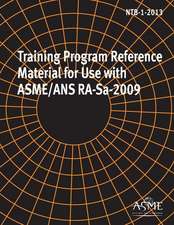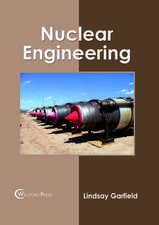Inertial Electrostatic Confinement (IEC) Fusion: Fundamentals and Applications
Autor George H. Miley, S. Krupakar Muralien Limba Engleză Hardback – 13 dec 2013
This book also:
Offers an in-depth look, from introductory basics to experimental simulation, of Inertial Electrostatic Confinement, an emerging method for generating fusion power
Discusses how the Inertial Electrostatic Confinement method can be applied to other applications besides fusion through theoretical experiments in the text
Details the study of the physics of Inertial Electrostatic Confinement in small-volume plasmas and suggests that their rapid reproduction could lead to the creation of a large-scale power-producing device
Perfect for researchers and students working with nuclear fusion, Inertial Electrostatic Confinement (IEC) Fusion: Fundamentals and Applications also offers the current experimental status of IEC research, details supporting theories in the field and introduces other potential applicationsthat stem from IEC.
| Toate formatele și edițiile | Preț | Express |
|---|---|---|
| Paperback (1) | 1046.67 lei 38-44 zile | |
| Springer – 27 aug 2016 | 1046.67 lei 38-44 zile | |
| Hardback (1) | 1223.39 lei 6-8 săpt. | |
| Springer – 13 dec 2013 | 1223.39 lei 6-8 săpt. |
Preț: 1223.39 lei
Preț vechi: 1491.93 lei
-18% Nou
Puncte Express: 1835
Preț estimativ în valută:
234.09€ • 245.07$ • 193.70£
234.09€ • 245.07$ • 193.70£
Carte tipărită la comandă
Livrare economică 05-19 aprilie
Preluare comenzi: 021 569.72.76
Specificații
ISBN-13: 9781461493372
ISBN-10: 1461493374
Pagini: 420
Ilustrații: XVIII, 400 p. 292 illus., 200 illus. in color.
Dimensiuni: 155 x 235 x 28 mm
Greutate: 0.76 kg
Ediția:2014
Editura: Springer
Colecția Springer
Locul publicării:New York, NY, United States
ISBN-10: 1461493374
Pagini: 420
Ilustrații: XVIII, 400 p. 292 illus., 200 illus. in color.
Dimensiuni: 155 x 235 x 28 mm
Greutate: 0.76 kg
Ediția:2014
Editura: Springer
Colecția Springer
Locul publicării:New York, NY, United States
Public țintă
ResearchCuprins
Background, Basics, and Experimental IECs.- Theory of Potential Well Traps in the IEC.- Gas Discharges in Gridded IECs.- High-Voltage Stalk Design for IECs.- IEC Grid Materials and Construction.- Effect of Grid Geometry on IEC Device Performance.- Space Charge Limited Flow.- Ion and Electron Current Scaling Issues.- Cylindrical and Other IEC Geometries.- Various Other IEC Concepts and Experiments.- IEC Diagnostics.- Potential Applications.- Reactor Confinement Theory and IEC Reactor Visions.
Textul de pe ultima copertă
This book provides readers with an introductory understanding of Inertial Electrostatic Confinement (IEC), a type of fusion meant to retain plasma using an electrostatic field. IEC provides a unique approach for plasma confinement, as it offers a number of spin-off applications, such as a small neutron source for Neutron Activity Analysis (NAA), that all work towards creating fusion power. The IEC has been identified in recent times as an ideal fusion power unit because of its ability to burn aneutronic fuels like p-B11 as a result of its non-Maxwellian plasma dominated by beam-like ions. This type of fusion also takes place in a simple mechanical structure small in size, which also contributes to its viability as a source of power. This book posits that the ability to study the physics of IEC in very small volume plasmas makes it possible to rapidly investigate a design to create a power-producing device on a much larger scale. Along with this hypothesis the book also includes a conceptual experiment proposed for demonstrating breakeven conditions for using p-B11 in a hydrogen plasma simulation.
This book also:
Offers an in-depth look, from introductory basics to experimental simulation, of Inertial Electrostatic Confinement, an emerging method for generating fusion power
Discusses how the Inertial Electrostatic Confinement method can be applied to other applications besides fusion through theoretical experiments in the text
Details the study of the physics of Inertial Electrostatic Confinement in small-volume plasmas and suggests that their rapid reproduction could lead to the creation of a large-scale power-producing device
Perfect for researchers and students working with nuclear fusion, Inertial Electrostatic Confinement (IEC) Fusion: Fundamentals and Applications also offers the current experimental status of IEC research, details supporting theories in thefield and introduces other potential applications that stem from IEC.
This book also:
Offers an in-depth look, from introductory basics to experimental simulation, of Inertial Electrostatic Confinement, an emerging method for generating fusion power
Discusses how the Inertial Electrostatic Confinement method can be applied to other applications besides fusion through theoretical experiments in the text
Details the study of the physics of Inertial Electrostatic Confinement in small-volume plasmas and suggests that their rapid reproduction could lead to the creation of a large-scale power-producing device
Perfect for researchers and students working with nuclear fusion, Inertial Electrostatic Confinement (IEC) Fusion: Fundamentals and Applications also offers the current experimental status of IEC research, details supporting theories in thefield and introduces other potential applications that stem from IEC.
Caracteristici
Offers an in-depth look, from introductory basics to experimental simulation, of Inertial Electrostatic Confinement, an emerging method for generating fusion power Discusses how the Inertial Electrostatic Confinement method can be applied to other applications besides fusion through theoretical experiments in the text Details the study of the physics of Inertial Electrostatic Confinement in small-volume plasmas and suggests that their rapid reproduction could lead to the creation of a large-scale power-producing device Includes supplementary material: sn.pub/extras






















